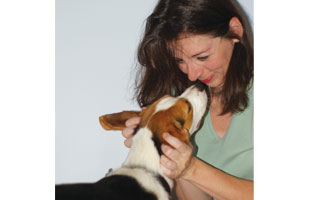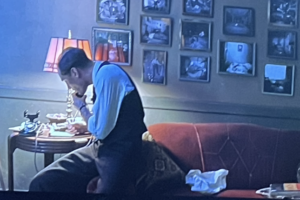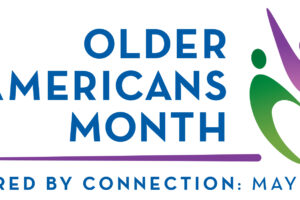 As we continue through the holiday season, one that is supposed to be for giving and being thankful for what we have, we should not forget our four-legged friends. More and more we are seeing how animals, mostly dogs, can help those who need it, and more and more groups are helping to train service dogs. With books on the best seller lists, and a movie or two in production about service dogs, our awareness and acceptance of these working dogs will only grow.
As we continue through the holiday season, one that is supposed to be for giving and being thankful for what we have, we should not forget our four-legged friends. More and more we are seeing how animals, mostly dogs, can help those who need it, and more and more groups are helping to train service dogs. With books on the best seller lists, and a movie or two in production about service dogs, our awareness and acceptance of these working dogs will only grow.
I do a lot of volunteering that involves dogs—my dog Giuseppe is a therapy dog who can be seen at the Warner Library some weekends with children reading to him. He also visits assisted living facilities. On Thursday mornings I drive up to Guiding Eyes and massage newborn puppies who will hopefully grow up to be service dogs. And if my dog and three cats are not enough, I take in service dogs-in-training a weekend or two a month through ECAD, (Educated Canines Assisting with Disabilities) based in Dobbs Ferry. (I wrote about that a couple of years ago in this publication.) My job those weekends is to reinforce what they have learned so far in their training and to socialize them in the “real world,” alerting the training staff to any issues that might impede their performance as a service dog such as pulling, excessive fear, or stubbornness –although one particularly stubborn pooch met her soulmate the third time they tried to pair her up. An older veteran won her heart and respect and she is happy with her job, despite having dug in her heels with the rest of us during her training. ECAD places dogs with people who have physical disabilities that involve mobility, whether a birth defect or an acquired injury. They do a lot of work with veterans, but also with civilians. Unlike Guiding Eyes and other facilities that train dogs for the visually impaired, ECAD’s clients are often confined to wheelchairs or have amputations.
Soon to be the most famous ECAD graduate is Tuesday, provided for Army veteran Luis Montalvan. His book Until Tuesday is being made into a Hollywood movie, and Mr. Montalvan has become quite famous himself on the talk circuit, Tuesday in tow, raising awareness about service dogs as well as about the less “visible” injuries of war including Post Traumatic Stress Disorder (PTSD) and brain injury that may result in balance issues that are not immediately visible at all times. I read the book over the summer and loved it. Another recent book is called Thunder Dog by Michael Hingson, about a guide dog who led her blind partner (Hingson) down the stairs during the World Trade Center attacks and shows us how amazing these dogs are—she was afraid of thunderstorms, not exactly the bravest guide dog, but did her job professionally and calmly when she knew her person was in trouble and needed her help. She even calmed others in the stairways and stopped to be petted by first responders who could use some encouragement. This book is also in the process of being made into a film.
Besides adding these books to your holiday wish list, they bring up something very important—the bond between human and animal and the good that we can teach these creatures to do. There are several organizations that breed service dogs, and they are growing every day, especially since Senator Al Franken has pushed for more funding for service dogs for veterans. You may not realize how much this is needed until you see the results. Yes, we are used to seeing guide dogs lead the blind, but we are not aware of all that they can do. In Mr. Montalvan’s class was a young woman who had lost her arms from an IED (Improvised Explosive Device). Her dog can pick things up for her, open doors, turn on lights, and this allows her to be more independent. A veteran with PTSD can be calmed during a nightmare by a dog who comes over to the bed and wakes him to comfort him. In Mr. Montalvan’s book he talks about how Tuesday helped him with terrible PTSD, headaches from injuries, and other issues to help him get his life back on track. Horses have also been used to help build balance and muscle tone for people recovering from injuries, or with congenital issues like cerebral palsy, as well as providing a benefit for children with emotional disabilities. In fact the dogs at ECAD are trained, in part, by children living in residential treatment centers such as Children’s Village, who have emotional and behavioral issues. They help the dogs and the dogs help them.
My own dog is not so highly trained, but when he visits the elderly and they tell me stories of dogs they had during their lives, he helps them feel connected to the world, they light up and become more energetic, and they relax while petting him. Children who read to him don’t feel self-conscious if they struggle or are just starting to learn because he doesn’t judge their abilities, he just likes to be petted and get the attention.
On occasion he’s come to my office with me, or I’ve gone to pick up an ECAD dog and had to rush back to the office, and my patients always light up when my co-therapists are there.
One of the biggest challenges now is having service dogs be accepted in society. Even though we’ve seen guide dogs for the blind for years, I have heard of people causing trouble for those who try to enter places like a restaurant with a service dog, even though it’s against the law to bar entry. Service dogs are a special group that are given full entry through the Americans with Disabilities Act, different from a therapy dog like mine, who must be wearing his Good Dog Foundation bandanna and be expected at the facility to be allowed into a place where dogs are not usually welcome. Because some injuries are not obvious, such as psychiatric disorders, head injuries, or seizures, those who have service dogs have experienced prejudice and been thrown out of businesses and other places because the owners or workers didn’t understand the need for the dog. Some dogs are trained to alert to seizures, so while someone may look fine entering a restaurant, the dog can be there to sense a seizure before it happens and prevent injury. Some dogs work with autistic children, keeping them from running off or calming them during a tantrum. The value of the dog may not be obvious right away, but any certified service dog is allowed in all public places.
So, this holiday season, besides buying these great books as stocking stuffers, consider volunteering with one of these organizations—they all need more help! When I get to snuggle a 10-day old puppy at Guiding Eyes I know that I’m part of a bigger system where the ultimate goal is for the dog to help a blind person gain more independence. In fact, right now I am babysitting a Guiding Eyes dog that belongs to a Tarrytown resident who needs to go somewhere tomorrow that he feels would be too loud and crowded for [the dog]. Giuseppe gets a sleepover and I get to enjoy the company of this well-trained guide dog. Many dogs don’t make it through the program as a guide dog, but may go on to help autistic children or work in law enforcement. Those who can’t do those things are adopted as family pets, and the adoption fee helps fund the programs, since service dogs are generally provided free of charge, however if there aren’t any shelters nearby then consider going on online puppy adoption sites to see if you can find your new companion. When I think of that young woman who, in the prime of life, lost her arms while serving in the military, it feels good to know that even if I only work with the dog on a few weekends, I’m part of what helps these dogs grow and develop and become service dogs someday for another injured or disabled person. Reading Mr. Montalvan’s book helped me to see the end result of working with these dogs in my small part.
Tuesday helped him move on to the next phase of his life, and got him back among the living, after coming back from terrible injuries and trauma. And I’m sure that during this holiday season he is grateful to have Tuesday in his life.
Happy holidays to all of you, and all your four-legged friends as well!
[blockquote class=blue]Barbara Kapetanakes, Psy.D, practices child, adult, and family psychotherapy in Sleepy Hollow. [/blockquote]






